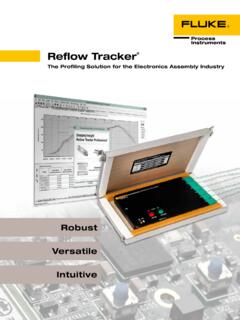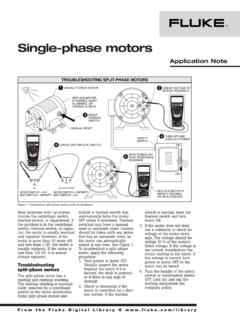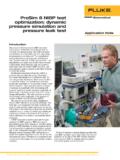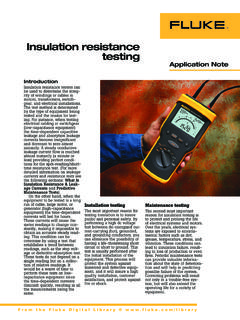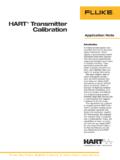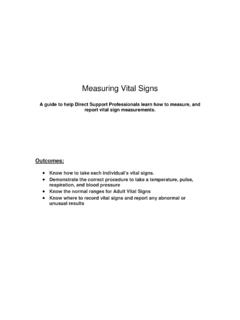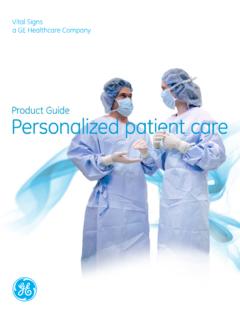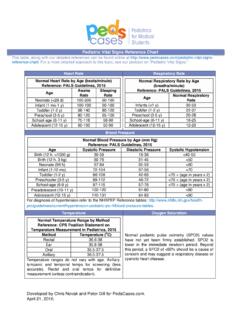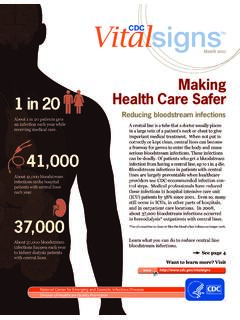Transcription of ProSim 8 Vital Signs Simulator - Support.Fluke.com
1 ProSim 8 Vital Signs Simulator The 8-in-1 ProSim 8 Vital Signs Simulator offers fast and comprehensive preventative maintenance (PM) testing for your entire patient monitor fleet. Designed to get you in and out of most PM locations in minutes, this multifunction Simulator tests ECG (including fetal ECG and arrhythmias), respiration, temperature, IBP, cardiac output, NIBP, SpO2, and is capable of testing Rainbow multi-wavelength waveforms. Featuring specialized stay-connected ECG posts for secure lead connections, physiolog-ically-synchronized pulses across all parameters, and customizable patient pre-sets and autose-quences, the ProSim 8 patient Simulator provides unbeatably fast and easy complete monitor testing.
2 Barcode-scanner compatibility and wireless PC interface, direct printing, data transfer and report-ing, along with advanced, integrated technologies and works-every-time performance allow top con-fidence in patient monitor fleet performance and supports passing regulatory audits with Data All-in-one complete monitor testing 80 % smaller and 17 kilos lighter than predecessor technology 8-in-1 multifunction Simulator tests ECG (including fetal ECG and arrhythmias), respiration, temperature, IBP, cardiac output, NIBP, SpO2, and Rainbow multi-wavelength waveforms Stay-connected ECG posts for easy/secure ECG snap and lead connections Custom SpO2 r-curve for accurate testing of the latest and future oximetry technologies Static pressure linearity testing Repeatable NIBP simulation (+/- 2 mmHg)
3 For dynamic pressure repeatability testing Physiologically synchronized pulses across all parameters Barcode scanning and direct data capture and printing functionality Onboard, customizable patient pre-sets and autosequences for fast/easy testing Multi-language user interface offers choice of language selection Integrated, easily-replaceable long-life battery Optional PC-interface software offers customizable procedures/checklists to replace bulky service manuals and automated data capture/storage* Wireless communication for remote PC control of test device, as well as data transfer and automated regulatory reporting**You must have Ansur Test Executive version or greater on your PC to communicate with the productKey features2 Fluke Biomedical ProSim 8 Vital Signs Simulator SpecificationsGeneral specificationsTemperatureOperating10 C to 40 C (50 F to 104 F)Storage-20 C to +60 C (-4 F to 140 F)Humidity10 % to 90 % non-condensingAltitude3,000 meters (9,843 ft)Dimensions (L x W x H) cm x cm x cm ( in x in x in)
4 DisplayLCD color displayCommunicationUSB device upstream portMini-B connector for control by a computerUSB host controller portType A, 5 V output, A max load. Connector for keyboard, barcode reader, and printerWirelessIEEE for control by a computerPowerLithium-ion rechargeable batteryBattery charger100 V to 240 V input, 15 A output. For best performance, the battery charger should be connected to a properly-grounded ac receptacleBattery life9 hours (minimum), 100 NIBP cycles kg ( lb)Safety standardsIEC/EN 61010-1 3rd Edition; Pollution degree 2 CAT NoneCertificationsCE, CSA, C-TICK N10140 , RoHSElectromagnetic compatibility (EMC)IEC 61326-1:20063 Fluke Biomedical ProSim 8 Vital Signs Simulator Detailed specificationsNormal-sinus-rhythm waveformECG referenceThe ECG amplitudes specified are for Lead II (calibration), from the baseline to the peak of the R wave.
5 All other leads are proportionalNormal sinus rhythm12-lead configuration with independent outputs referenced to right leg (RL). Output to 10 universal ECG jacks, color-coded to AHA and IEC standardsHigh-level V/mV 5 % of the ECG amplitude setting available on a BNC mV to mV ( mV steps); mV to mV ( mV steps) Other leads are proportional to Lead II (reference lead) in percentage per:Lead I: 70 Lead II: 100 Lead III: 30 Lead V1: 24 Lead V2: 48 Lead V3: 100 Lead V4: 120 Lead V5: 112 Lead V6: 80 Amplitude accuracy (2 % of setting + mV) ECG rate10 BPM to 360 BPM in 1 BPM stepsRate accuracy 1 % of settingECG waveform selectionAdult (80 ms) or pediatric (40 ms) QRS durationST-segment elevationAdult mode only.
6 MV to + mV ( mV steps). Additional steps: + mV and - mVPower-on default60 BPM, mV, adult QRS and ST-segment elevation of 0 mVPacemaker waveformPacer pulseAmplitude0 (off), 2, 4, 6, 8, 10, 12, 14, 16, 18, 20, 50, 100, 200, 500, and 700 mV for lead II (reference lead)AccuracyReference lead II: (5 % setting + mV)All other leads: (10 % setting + mV)Pacer pulse ms, ms, ms, 1 ms, and 2 ms 5 %Paced arrhythmiasAtrial 80 BPMA synchronous 75 BPMD emand with frequent sinus beatsDemand with occasional sinus beatsAtrio-ventricular sequentialNoncapture (one time)NonfunctionPower-on defaultAmplitude 5 mV, width 1 ms, atrial waveform4 Fluke Biomedical ProSim 8 Vital Signs Simulator ArrhythmiaBaseline NSR80 BPMPVC focusLeft focus, standard timing (except where specified)Supraventricular arrhythmiaAtrial fibrillation (coarse or fine); atrial flutter; sinus arrhythmia; missed beat (one time); atrial tachycardia.
7 Paroxysmal atrial tachcar-dia; nodal rhythm; and supraventricular tachycardiaPremature arrhythmiaPremature atrial contraction (PAC); premature nodal contraction (PNC); PVC1 left ventricular; PVC1 left ventricular, early; PVC1 left ventricular, R on T; PVC2 right ventricular; PVC2 right ventricular, early; PVC2 right ventricular, R on T; and multifocal PVCsVentricular arrhythmiaPVCs 6, 12, or 24 per minute; frequent multifocal PVCs; bigeminy; trigeminy; multiple PVCs (one-time run of 2, 5, or 11 PVCs); mono-ventricular tachycardia (120 to 300 BPM in 5 BPM steps); poly-ven-tricular tachycardia (5 types); ventricular fibrillation (coarse or fine); and asystoleConduction defectFirst-, second-, or third-degree heart block.
8 And right- or left-bundle-branch blockAdvanced cardiac life supportShockable pulseless arrest rhythmsVentricular fibrillation (coarse), ventricular fibrillation (fine), unstable polymorphic ventricular tachycardiaNon-shockable pulseless arrest rhythmsAsystoleSymptomatic bradycardiaSinus bradycardia (< 60 BPM)2nd degree AV block, mobitz type I2nd degree AV block, mobitz type IIComplete/3rd degree AV blockRight bundle branch blockLeft bundle branch blockAdvanced cardiac life support tachycardia: regular narrow-complex tachycardia (QRS < seconds)Sinus tachycardia > 150 BPMS upraventricular TachycardiaSymptomatic tachycardia: regular wide-complex tachycardias (QRS seconds)Sinus tachycardia > 150 BPMS upraventricular tachycardia SVT with aberrancyIrregular tachycardiaAtrial fibrillation (coarse and fine), atrial flutter, unstable monomor-phic ventricular tachycardia (120 BPM to 300 BPM), torsade de pointes/polymorphic ventricu-lar tachycardia (long QT interval)5 Fluke Biomedical ProSim 8 Vital Signs Simulator ECG Performance mV to mV ( mV steps).
9 MV to mV ( mV steps) Other leads are proportional to Lead II (reference lead) in percentage per:Lead I: 70 Lead II: 100 Lead III: 30 Lead V1 through V6: 100 Pulse wave30 BPM, 60 BPM, with 60 ms pulse widthSquare Hz, 2 Hz, HzTriangle Hz, 2 Hz, HzSine Hz, Hz, 1, 2 Hz, 5 Hz, 10 Hz, 25 Hz, 30 Hz, 40 Hz, 50 Hz, 60 Hz, 100 Hz, and 150 HzR-wave detectionWaveformTriangular pulseRate30 BPM, 60 BPM, 80 BPM, 120 BPM, 200 BPM, and 250 BPMW idth8 ms to 20 ms in 2 ms steps, and 20 ms to 200 ms in 10 ms stepsWidth accuracy (1 % of setting + 1 ms)QRS detectionWidths8 ms to 20 ms in 2 ms steps, and 20 ms to 200 ms in 10 ms stepsWidth accuracy (1 % of setting + 1 ms)
10 Rate30 BPM, 60 BPM, 80 BPM, 120 BPM, 200 BPM, and 250 BPMR-Wave up amplitude, x widthR-Wave down slopeFull amplitude, x widthS-Wave up amplitude, x widthTall T-wave rejectionWaveformQT Interval 350 msT-Wave width 180 msT-Wave shape sinewaveAmplitude0 % to 150 % reference lead amplitude in 10 % stepsRate80 BPMRate accuracy 1 % of settingAmplitute accuracy (2 % of setting + mV) ECG artifactType50 Hz, 60 Hz, muscular, baseline wander, respirationSize25 %, 50 %, 100 % of the normal sinus R-Wave for each leadLead selectAll, RA, LL, LA, V1, V2, V3, V4, V5, V66 Fluke Biomedical ProSim 8 Vital Signs Simulator Fetal/Maternal ECGF etal heart rate (fixed)60 BPM to 240 BPM in 1 BPM stepsFetal heart rate (IUP)140 BPM at beginning, then varies with pressureIntrauterine-pressure waveformsEarly deceleration, late deceleration, and accelerationWave duration90 seconds, bell-shaped pressure curve, from 0 mmHg to 90 mmHg and returning to 0 IUP period2 min, 3 min, or 5 minutes.




